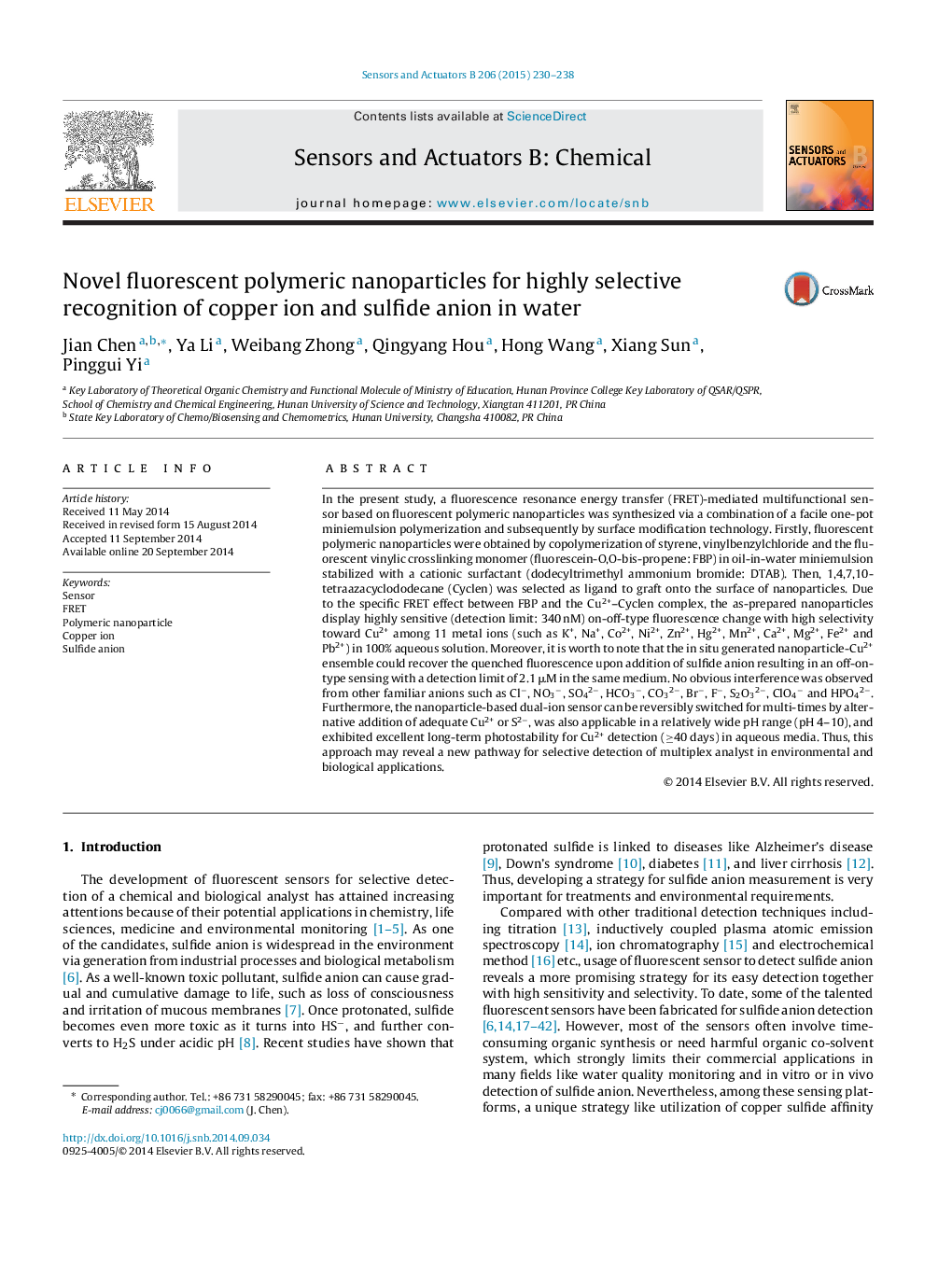| Article ID | Journal | Published Year | Pages | File Type |
|---|---|---|---|---|
| 744363 | Sensors and Actuators B: Chemical | 2015 | 9 Pages |
•The FPNs sensor was prepared by miniemulsion polymerization and surface grafting.•The sensor can selectively detect copper ion and sulfide anion in water.•The detection limit of sensor is 340 nM for Cu2+ and 2.1 μM for S2−.•The sensor was applicable in a relatively wide pH range (4–10).•The sensor exhibited excellent long-term photostability for Cu2+ detection (≥40 days).
In the present study, a fluorescence resonance energy transfer (FRET)-mediated multifunctional sensor based on fluorescent polymeric nanoparticles was synthesized via a combination of a facile one-pot miniemulsion polymerization and subsequently by surface modification technology. Firstly, fluorescent polymeric nanoparticles were obtained by copolymerization of styrene, vinylbenzylchloride and the fluorescent vinylic crosslinking monomer (fluorescein-O,O-bis-propene: FBP) in oil-in-water miniemulsion stabilized with a cationic surfactant (dodecyltrimethyl ammonium bromide: DTAB). Then, 1,4,7,10-tetraazacyclododecane (Cyclen) was selected as ligand to graft onto the surface of nanoparticles. Due to the specific FRET effect between FBP and the Cu2+–Cyclen complex, the as-prepared nanoparticles display highly sensitive (detection limit: 340 nM) on-off-type fluorescence change with high selectivity toward Cu2+ among 11 metal ions (such as K+, Na+, Co2+, Ni2+, Zn2+, Hg2+, Mn2+, Ca2+, Mg2+, Fe2+ and Pb2+) in 100% aqueous solution. Moreover, it is worth to note that the in situ generated nanoparticle-Cu2+ ensemble could recover the quenched fluorescence upon addition of sulfide anion resulting in an off-on-type sensing with a detection limit of 2.1 μM in the same medium. No obvious interference was observed from other familiar anions such as Cl−, NO3−, SO42−, HCO3−, CO32−, Br−, F−, S2O32−, ClO4− and HPO42−. Furthermore, the nanoparticle-based dual-ion sensor can be reversibly switched for multi-times by alternative addition of adequate Cu2+ or S2−, was also applicable in a relatively wide pH range (pH 4–10), and exhibited excellent long-term photostability for Cu2+ detection (≥40 days) in aqueous media. Thus, this approach may reveal a new pathway for selective detection of multiplex analyst in environmental and biological applications.
Graphical abstractNovel FRET-mediated fluorescent polymeric nanoparticles for highly sensitive (detection limit: 340 nM for Cu2+ and 2.1 μM for S2−) and selective recognition of copper ion and sulfide anion in water were prepared by a facile miniemulsion polymerization and subsequent surface grafting strategy. The nanoparticle-based dual-ion sensor can be reversibly switched for multi-times by alternative addition of adequate Cu2+ or S2−, and was also applicable in a relatively wide pH range (pH 4–10), exhibited excellent long-term photostability for Cu2+ detection (≥40 days) in aqueous media.Figure optionsDownload full-size imageDownload as PowerPoint slide
